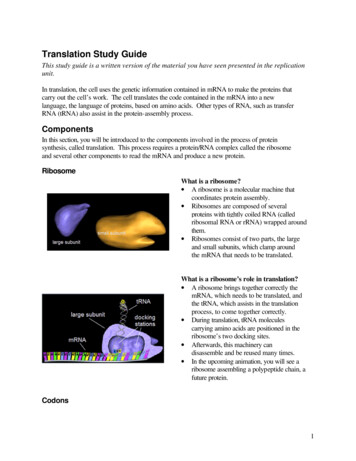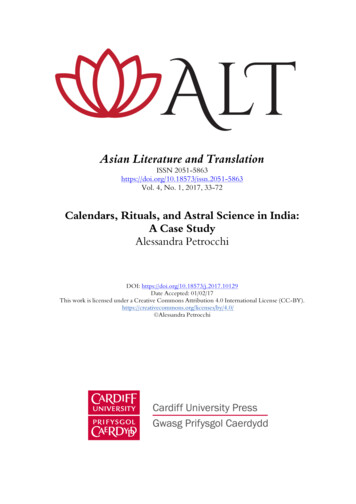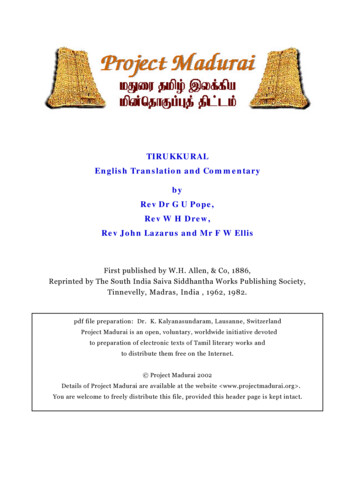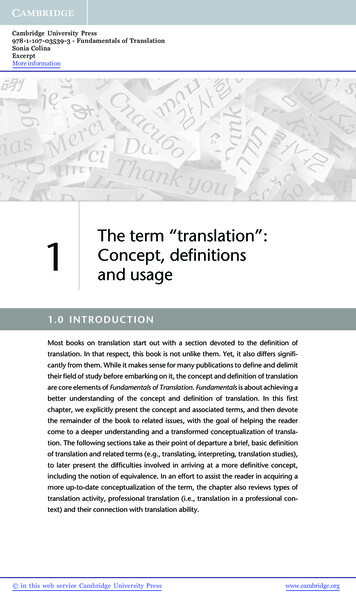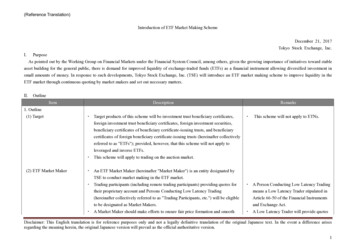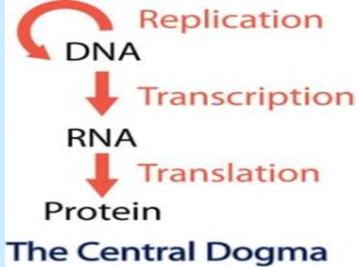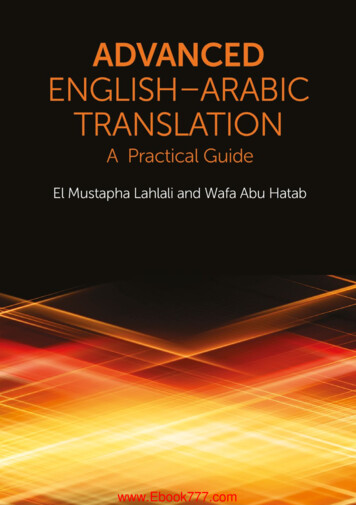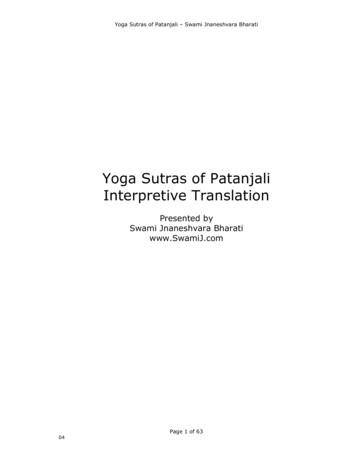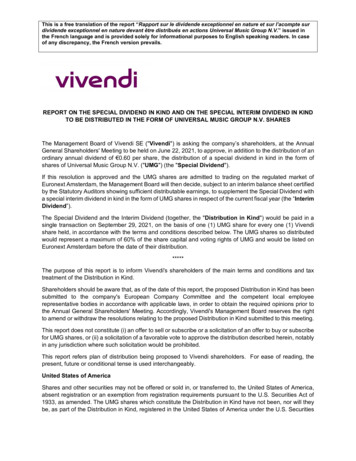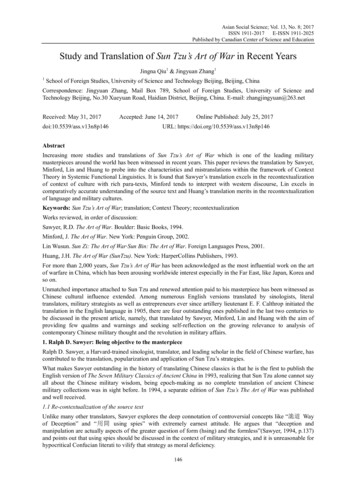
Transcription
Asian Social Science; Vol. 13, No. 8; 2017ISSN 1911-2017E-ISSN 1911-2025Published by Canadian Center of Science and EducationStudy and Translation of Sun Tzu’s Art of War in Recent YearsJingna Qiu1 & Jingyuan Zhang11School of Foreign Studies, University of Science and Technology Beijing, Beijing, ChinaCorrespondence: Jingyuan Zhang, Mail Box 789, School of Foreign Studies, University of Science andTechnology Beijing, No.30 Xueyuan Road, Haidian District, Beijing, China. E-mail: zhangjingyuan@263.netReceived: May 31, 2017Accepted: June 14, 2017doi:10.5539/ass.v13n8p146Online Published: July 25, 2017URL: asing more studies and translations of Sun Tzu’s Art of War which is one of the leading militarymasterpieces around the world has been witnessed in recent years. This paper reviews the translation by Sawyer,Minford, Lin and Huang to probe into the characteristics and mistranslations within the framework of ContextTheory in Systemic Functional Linguistics. It is found that Sawyer’s translation excels in the recontextualizationof context of culture with rich para-texts, Minford tends to interpret with western discourse, Lin excels incomparatively accurate understanding of the source text and Huang’s translation merits in the recontextualizationof language and military cultures.Keywords: Sun Tzu’s Art of War; translation; Context Theory; recontextualizationWorks reviewed, in order of discussion:Sawyer, R.D. The Art of War. Boulder: Basic Books, 1994.Minford, J. The Art of War. New York: Penguin Group, 2002.Lin Wusun. Sun Zi: The Art of War·Sun Bin: The Art of War. Foreign Languages Press, 2001.Huang, J.H. The Art of War (SunTzu). New York: HarperCollins Publishers, 1993.For more than 2,000 years, Sun Tzu’s Art of War has been acknowledged as the most influential work on the artof warfare in China, which has been arousing worldwide interest especially in the Far East, like Japan, Korea andso on.Unmatched importance attached to Sun Tzu and renewed attention paid to his masterpiece has been witnessed asChinese cultural influence extended. Among numerous English versions translated by sinologists, literaltranslators, military strategists as well as entrepreneurs ever since artillery lieutenant E. F. Calthrop initiated thetranslation in the English language in 1905, there are four outstanding ones published in the last two centuries tobe discussed in the present article, namely, that translated by Sawyer, Minford, Lin and Huang with the aim ofproviding few qualms and warnings and seeking self-reflection on the growing relevance to analysis ofcontemporary Chinese military thought and the revolution in military affairs.1. Ralph D. Sawyer: Being objective to the masterpieceRalph D. Sawyer, a Harvard-trained sinologist, translator, and leading scholar in the field of Chinese warfare, hascontributed to the translation, popularization and application of Sun Tzu’s strategies.What makes Sawyer outstanding in the history of translating Chinese classics is that he is the first to publish theEnglish version of The Seven Military Classics of Ancient China in 1993, realizing that Sun Tzu alone cannot sayall about the Chinese military wisdom, being epoch-making as no complete translation of ancient Chinesemilitary collections was in sight before. In 1994, a separate edition of Sun Tzu’s The Art of War was publishedand well received.1.1 Re-contextualization of the source textUnlike many other translators, Sawyer explores the deep connotation of controversial concepts like “詭道 Wayof Deception” and “用間 using spies” with extremely earnest attitude. He argues that “deception andmanipulation are actually aspects of the greater question of form (hsing) and the formless”(Sawyer, 1994, p.137)and points out that using spies should be discussed in the context of military strategies, and it is unreasonable forhypocritical Confucian literati to vilify that strategy as moral deficiency.146
ass.ccsenet.orgAsian Social ScienceVol. 13, No. 8 2017Sawyer pointed out in the preface that in order to gain a better understanding of Sun Tzu’s era, “it is worthwhileto reconstruct many facets of Spring and Autumn political and economic life” (Sawyer, 1994, p.85), hence histranslation is far more than mere translated texts, but includes rich para-texts mounting to over 200 pages tore-contextualize the political situation, economic development, military organization and linguistic culture ofsource text.For example, he briefly introduces the social stratification of Shang Dynasty and the feudal system ofland-holding in Zhou Dynasty. In terms of economic background, he touches on the agricultural economy, the“井田制 nine squares” system (of land ownership in China's slave society) , relates the bronze and metallurgytechnology to the weaponry improvement and provides a brief discussion of the then economic situation andsystem of different states.Sawyer’s The Art of War is especially conspicuous in the introduction of military background information. Henot only mentions the historical disturbance and turmoil but also gives a comparatively detailed account ofShang, Western Chou, Wu, Ch’u and Yüeh states. He exemplifies the application of Sun Tzu’s strategies in thewars among Shang, Zhou and other states. Based on historical records, Sawyer depicts strategic layout andtactical map of battle of“雞父之戰 battle of Chi-fu” between Wu and Ch’u and that of “笠澤之戰 battle of Li-cheriver” between Wu and Yüeh.Besides, Sawyer expounds the military culture in five aspects: firstly, the traces back the origin of ancientmilitary thoughts and introduces the composition of the seven military classics of ancient China; then heaccounts the warfare mode and tactics in Shang and the Warring States Period; he explicates the militaryorganization of “軍 Chün”, “旅 lü”, “卒 tsu”, “伍 wu”, “師 shih” according to 周禮 Chou Li. He devotesseparate sections to the explication of weapons like 戰車 Chariots, 弩 crossbows and main concepts like “仁Benevolence”, “勢 Shih” and “五德 the five virtues of warfare” and so on.1.2 Domestication: say it in the western waySawyer targets at a general readership, hence he adopts Domestication translation to adapt to the context of targetlanguage. He seeks for conceptual equivalence by replacing the source text with western terms familiar with thepotential reader in order to improve the readability. Take the terms of measure and weight as an example, Sawyertends to transliterate or use western replacement. He translates “裡 li/鐘 zhong/石 dan” into “Li”, “bushel” and“picul” respectively. See the following �稱鎰(形篇)(gu Shengbing ruo yiyichengzhu, baibing ruo yizhuchengyi)Sawyer: Thus the victorious army is like a ton compared with an ounce, while the defeated army is like an ounceweighed against a ton!Sun Tzu used“ 鎰 ”and“ 銖 ”, two ancient measurement units which has undergone dramatic change incontemporary China to emphasize the discrepancy between winner and loser in warfare. Sawyer replaces themwith “ton” and “ounce” to relieve the reading burden and cater to the cultural schema of the target reader.However, too much westernization may turn out to be defective. Take the translation of core term “天 tian” asan instance, it is a philosophical concept in Sun Tzu’s Art of War, referring to the natural or philosophicalexistence related to military meteorology or tactical organization with no touch of religious connotation. Sawyerreplaces it with the western equivalence “Heaven”, solving the problem of conceptual vacancy, but conjuring upthe correlation with the Creator/God, the concept of soul and sin on the reader’s part (Roger Ames, 2002, p.18).The additional religious flavor imposed on Sun Tzu deviates from the dialectical materialism of the source text.Besides, Sawyer caters to the reader’s expectancy by providing translations of others translators like Griffth,Giles, and Cleary and so on occasionally to facilitate inter-text comparison and improves the credibility of thetranslation itself.1.3 Foreignization: cultural equality and the OtherFrom the translation of Sun Tzu to the explication of The Tao of Deception: Unorthodox Warfare in Historic andModern China, Tao of Spycraft, Fire and Water: The Art of Incendiary and Aquatic Warfare in China and otherwritings concerning Chinese martial arts, Sawyer exhibits attitude of cultural equality and respect. Therefore,while translating Sun Tzu, he pays special attention to the concepts and terms unique to Chinese culture byintegrating transliteration, annotation and other Foreignization approaches to enhance the semantic fullness anddecrease the semantic loss in inter-lingual transformation.For the core term 勢 Shi, Sawyer varies the translation according to the concrete context into “strategic military147
ass.ccsenet.orgAsian Social ScienceVol. 13, No. 8 2017power (Shih)”,“strategic power” and “strategic configuration of power (Shih)”, each with English equivalenceand transliteration to decrease the semantic loss. Similarly, he translates 奇 Qi and 正 Zheng into “unorthodox(ch’i)” and “orthodox (cheng)”。For the key philosophical term 道 Dao in pre-Qin history, Sawyer translates it into Tao or the form of “the Way(Tao) (to/for/of )”, with detailed annotation concerning the origin and connotation of it with evidence fromChinese Classics 道德經 Tao Te Ching and so on, in order to provide necessary supplement while solving theproblem of untranslatability and keeping the exotic flavor of the term. This approach is repeatedly applied to thetranslation of “四帝 the four emperor”, “氣 Qi”, “霸王 hegemony” and other terms peculiar to Chinese.However, too much Foreignization without annotations hinders the understanding. For example, Sawyertransliterates the philosophical term 陰陽 into “yin and yang” without any explication. For the generalreadership without special knowledge precipitation of ancient China, this translation is obviously inadequate.1.4 Linguistic aspect and misreading: inspect into the insiderTranslation assessment inevitably involves that of the linguistic aspect. Sawyer’s translation of Sun Tzu dealswell with semantic fullness, rhetoric restoration and lexical manipulation.For most cases, he does word-to-word translation and provide supplement in square brackets to facilitateunderstanding, guarantee discourse coherence, add interlinear noting or parallelize the original modal particlewhile keeping the lines running smooth and reducing reading interference. The translation of “天地孰得 TiandiShu De” into “Who has gained [the advantages of] Heaven and Earth” is a proper case. Sawyer reads betweenthe lines and digs out that the authentic object of 得 is the advantage of 天地, hence puts the exploitation inbrackets to aid others’ reading.Sawyer does a lot of interlinear contextualization as well. For example, he translates Chi Che 馳車 and Fen Wen轒轀 into “four-horse attack chariots” and “armored assault wagons” respectively,emphasizing the structure,nature and offense application of them.As for the rhetoric, Sawyer attempts to assemble the conciseness, rhythm and rhetorical approaches of the sourcetext. He puts “fu bingjiu er guolizhe, weizhiyou ye 夫兵久而國利者,未之有也” into “No country has everprofited from protracted warfare”, with only eight words, being far simpler than Lin’s “For there has never beena prolonged war from which a country has benefited”(Lin, 2001, p.13).When it comes to metaphors, parallelism, anadiplosis and other modes of rhetoric, Sawyer tends to be faith to theoriginal. For example, he translates �則急於丘役 jinshizhe guimai, guimaize baixing caijie, caijie ze jiyu qiuyi” into “Those in proximity to the army will sell their goods expensively.When goods are expensive, the hundred surname’s wealth will be exhausted. When their wealth is exhausted,they will be extremely hard pressed [to supply] their village’s military impositions”. By imitating the anadiplosis,the translated text exhibits the interlinear logic between inflation of prices, impoverishment of the folk andurgency to warfare clearly.The lexical treatment is worth mentioning as well. Take ��間、反間、死間和生間 gu yongjian youwu: you yinjian, you neijian, you fanjian, yousijian, you shengjian ” as an example, Sawyer translates it into “Thus there are five types of spies to be employed:local spy, turned spy [double agent], dead [expendable] spy, and the living spy”. Relating 反间 and 死间 todouble agent and expendable spy respectively is refreshing and eye-catching. He puts “不竭如江河 bujie rujianghe” into “as unlimited as the Yangtze and Yellow rivers”, adding sort of exotic flavor by specifying rivers tothe symbolic river of China.Despite the rigorous academic exploration of the source text, deviations and misreading exist in Sawyer’stranslation, mainly in misreading of core terms and break of cultural convention. Sawyer translates “分數fenshu”, a military term unique to Sun Tzu, referring to the organization approach of organizing and managingsoldiers in different classification, entailing the effect of managing a large number of soldiers the same as that offew soldiers, into “a question of dividing up the numbers”, hence hinders the accurate understanding of thesource text. Instead, “a matter of organization” may cater to the cultural logic better. For cultural convention, SunTzu has a famous saying ��者也”,in which“朝/晝/暮”has undergone dramatic change in meaning. The original referring to timing has beenconverted to symbolize the beginning, duration and ending of certain periods. But Sawyer still translates theminto “in the morning/during the day/at dusk”, which clearly violates the cultural convention of Sun Tzu.Of course, the flaws do not detract from the jade's essential beauty. Sawyer’s translation of Sun Tzu iscomparatively advantageous in the scrupulously supplemented contextualization and agile integration of148
ass.ccsenet.orgAsian Social ScienceVol. 13, No. 8 2017Domestication and Foreinization as well as semantic fullness and modernized lexical manipulation.2. John Minford: Interpreting Sun Tzu with western discourseJohn Minford, a sinologist and literary translator, has been an experienced translator of Chinese classics,including the last 40 chapters of Hongloumeng together with sinologist and his father-in-law David Hawkes,Louis Cha's The Deer and the Cauldron and a selection of Pu Songling's Strange Tales from a Chinese Studio,The Art of War and I Ching.Minford embarks on the translation of Sun Tzu’s Art of War at the invitation of Penguin Group, and published thetranslation in 2002, warmly received and appreciated for the simple wording and resembling rhythm of thesource text, which leads to the necessity of reviewing the work in this article.2.1 Scaffolding the reader: contextualization and reader-consciousnessTo avoid interfering with the reading, Minford creatively separates his version into three parts, i.e. pre-textintroduction to re-contextualize Sun Tzu and his work, translated text itself without any notes or annotations toprovide unadorned reading experience of the original culture and translation with annotations for furtherexplanations.Minford applies rich para-texts to provide background information about Sun Tzu, the translation itself,pronunciation and reference suggestion in roughly 60 pages. But unlike Sawyer’s objective contextualization,Minford tends to express personal judgment, guiding the reading perspectives of the potential reader.While introducing the Spring and Autumn period, Minford studiously emphasizes the then turmoil and tanglingsituation. He briefly accounts the arrows, chariots and other weapons; provides the basic information of Sun Tzuand Sun Pin; exemplify core concepts like 勢 shi; Lists the names of annotators of Sun Tzu like Caocao,Zhangyu and many others; and offers a list of chronology of Chinese dynasties as well. Besides, Minfordmentions historical personage Zhuge Liang (the Sleeping Dragon), litterateur Liu Xie and Ouyang Xiu, greatthinkers Confucius, Mencius and Chinese Classics like The Book of Changes, The Romance of the ThreeKingdoms and so on to reconstruct the diachronic context of the source text.Minford applies 1,100 pieces of annotations and running commentaries for further contrast and explanation,mainly in three categories. Firstly, listing or citing from over 15 Chinese Classics including The Book of Mencius,The Book of Lord Shang, Record of the Grand Historians, The Book of Zhuangzi, The Zuo Commentary; then,listing or quoting the views of over 16 ancient and contemporary Chinese annotators and scholars of Sun Tzu;Minford cites the translation of other translators, like Giles, Roger Ames, Griffth and Jean Lévy and so on.Besides, Minford adds 125 pieces of translator notes to provide further explain, contrast and personal commentconcerning eight categories, i.e. brief introduction of core terms like “道 dao”,“陰陽 yin yang” and “勢 shi”;synopsizing Proper Names like “诸侯 zhu hou” and “吕牙 lü Ya”; making contrast between the Song versionand unearthed Yinqueshan bamboo strips in Han tombs; validating the translation wording; commenting on thesource text; summarizing main points of a certain chapter; criticizing views of other scholars and expoundingcultural connotations of certain terms.For example, Minford claims that he cares less about the concrete numbers appearing in Sun Tzu, but focuses onthe discrepancy indicated by them, hence he even translates “百里”、“五十裡”和“三十裡” into “Thirtymiles/fifteen miles/ten miles”.Objectively speaking, Minford’s endeavor to resort to a hotchpotch of resources for explanation eases thereading burden to a great extent by reconstructing the historical and social background of Sun Tzu and hismasterpiece, but with occasional ineffective or defective analogy in the annotations. For example, at the firstappearance of key term 道 dao in the first chapter, Minford juxtaposes the line “譬道之在天下,猶川谷之于江海 All under heaven will be drawn to the Way, as streams and torrents flow into a great river or sea” (Minford,2002, p.102) there without any explanation, which may lead to confusion between core concepts in Sun Tzu andThe Way and Its Power.2.2 Analogizing between Orient and OccidentWith a general western readership as the target, Minford caters to the reading expectancy and culturalpsychology through annotating and analogizing the Orient with the Occident.For example, Minford points out that Sun Tzu’ saying “投之亡地然後存,陷之死地然後生 Plunge them intodeath ground, and they will live”(Minford, 2002, p. 298) resembles the western saying “Nothing ventured,nothing gained” to activate the cultural schema of the potential reader.149
ass.ccsenet.orgAsian Social ScienceVol. 13, No. 8 2017When it comes to tactical strategies or maneuver tactics, Minford tends to make analogies with those practicedby western military elites, such as Napoleon, Caesar, Marlborough and Wellington. Besides, numerous westernbattles like the battle of Waterloo, the Gallic wars and the battle of the river Trebbia, military works likeClausewitz’s On war and World History of the Art of War, and figures and historical events from the westernworld like England poet Edward Young, drama Tyrannic Love, philosopher Angus Charles Graham, Greecehistorian Polybius, French sociologist and sinologist Marcel Granet are cited or briefly mentioned to relieve thereaders from struggling with pure Oriental events and thought.With respect to other translators, Minford cites and quotes Giles for over 130 times, praising Giles’ translation asone being able to stand the test of time admirably, standing out in at least three aspects, namely the referring towestern figures like Greece writer and historian Herodotus and Thucydides, Roman history Livy, Americangeneral Baden-Powell, Stonewall Jackson, Hannibal, Napoleon and so on; the appropriate dealing with militaryterminology and the expanded annotation and criticism of Sun Tzu.2.3 Adapting the language: Linguistic simplification and rewritingWhile attempting to keep faithful to the original content, Minford makes adjustment and rewriting of thelanguage to satisfy the literate necessity of general readership, mainly in four ways, i.e. decrease the linguisticdifficulty by application of nominalization, rewrite certain situations to make it more narrative-like, switch thenarrative perspective to enhance interactivity and adjust cohesive devices to enhance coherence and cohesion ofthe discourse.Take the high frequency construction of 者 zhe for example, Minford translates them into noun groups like “TheSkilful Warrior/A Skilful Defender/A Skilful Attacker/The Skilful Warrior of old” instead of embedded clauselike “one /those that [who excels at warfare/war/defense/in warfare]” applied by Sawyer and other translators,entailing comparative conciseness and relatively greater readability.Minford changes certain situations to enhance the sense of narration. For example, he translates “士卒坐者涕沾襟,偃卧者涕交颐 Tears may soak the garments of those sitting and wet the faces of those lying down (Lin, 2001,p.89) ” into “They sit up and weep, wetting their clothes with their tears; They lie down and weep, wetting theircheeks”. The change of soldiers as protagonist into “he” as a sole leading role deviates from the original text, butthrough narrating the “story” around a single soldier, the translator depicts the sorrow and grief before battlesvividly.Simplification for readability can be acceptable, but oversimplification resulting in distortion of the source text isnot. Minford translates “守则不足,攻则有余” into “Defense implies Lack; Attack implies abundance”. Despitethe seemingly conciseness of wording, the translation exhibits inadequacy in logic interpretation: defense is notnecessarily due to lack and attack does not inevitably presuppose abundance, otherwise 分數 fen shu would nothave existed.Minford switches narrative perspectives and modulates the system of Modality to enhance the objectiveatmosphere and readability of the translated text. He applies the third singular abundantly while using fewsecond person “you”, to isolate the reader from the “story” and increase a touch of dedicative flavor. Toconsolidate the objectivity and conciseness, he switches some declarative clauses into imperatives and deletescertain modal verbs, which leads to deviations as well. For example, by putting “上下同欲者勝” into “Haveofficers and men who share a single will”, deviation from “the party who can make the officers and men share asingle will can be victorious” occurs.The most conspicuous advantage claimed for Minford’s translation may be the restoration of rhythm of thesource text. He breaks the source text into different lines with the form similar to English poems to create a senseof rhyming, with frequent alliterative, end rhyme and internal rhyme. Take the translation of �羊,驅而往,驅而來,莫知所之”as an example.He leads his men into battleLike a manClimbing a heightAnd kicking away the ladder;He leads themDeep into the territoryOf the feudal lordsAnd releases the trigger.He burns his boats,150
ass.ccsenet.orgAsian Social ScienceVol. 13, No. 8 2017He breaks his pots.He is like a shepherdDriving his sheepThis way and that;No one knowsWhere he is going.Long and short clauses in different lines create a sense of rhyming. Besides, “shepherd” and “sheep” form thealliterative of /ð/; “releases/burns/breaks” forms end rhyme of /ʃ/; “ladder” and “trigger” forms /ə/rhyme and“boat/pots” creates /ts/ rhyme.Minford excels at enhancing the dynamic description of situations through such adaptations, but with certaindeviations due to excessive pursuit of formal equivalence to the source text. For instance, many connectivewords like “是故/故 therefore/hence” are deleted for the sake of conciseness and rhyme, resulting in theoversimplification of logico-semantic relations.2.4 Painful lesson: cultural misreadingMinford claims that he is most satisfied with his translation of Sun Tzu and attempts to keep faith to the sourcetext. But astonishingly, his para-texts overflow with cultural discrimination and misreading.As mentioned previously, Minford tries to add personal interpretation instead of reconstructing the contextobjectively like Sawyer does. He misreads the concept of 詭道 and devotes two sections in the preface under theheadline of “The Way of War is a Way of Deceptions” and “Cunning Plans, Popular Culture” to expound withthe stories of Han Xin and the Sleeping Dragon to prove his false assumption that Sun Tzu uses 詭道 to deceiveand make use of other people. As a matter of fact, 詭道 is a way of changing, just as Sawyer puts it in his workTao of Spycraft, a way of varying approaches at the level of strategies instead of moral judgment, which is farfrom being “shocking” as Minford claims.According to Minford, Sun Tzu is completely different from Confucianism in the attitude towards warfare. Infact, just as Confucius is against war and advocates benevolence and righteousness in war, Sun Tzu emphasizesthe same by prudence on initiating wars in lines “亡國不可以複存,死者不可以複生 A vanquished state cannotbe revived, the dead cannot be brought back to life” , preservation in ing the enemy’s army without fighting is the true pinnacle of excellence” and “善而養之 Treat thecaptured soldiers well” and so on. Griffth once pointed out that Sun Xingyan is right in saying that Sun Tzu’stheory is based on benevolence and righteousness.Minford depreciates Legalism and equals it with Chinese Fascists, saying that Legalism abducts Daoismdoctrines and deviates from the "Nature and Humanity" ideology. He analogizes Sun Tzu’s Art of War with thesex book Wonderful Disquisition of the Plain Girl, hence vulgarizing and vilifying Chinese culture.Direct sarcasm towards Chinese people and culture can be found in the annotations. For example, annotator JiaLin lists ways of causing harms to the opposing army for “是故屈诸侯者以害”, while Minford quotes Giles that“some of the ways of inflicting this injury enumerated by Jia Lin would only occur to the Oriental mind”(Minford, 2002, p. 221). In the chapter of using spies, Giles comments that Chinese people are peace-loving,while Minford jots that “Gile’s comment, though not of strict relevance or even necessarily true, is challengingand of considerable intrinsic interest his idea, that the true object of war is peace, has its root in the nationaltemperament of the Chinese”(Minford, 2002, p. 316).As a whole, Minford’s translation is advantageous in catering to the western world in analogizing the east withthe west, excels at concise words and restoration of rhythm, but is far less faithful to the source text than Sawyer,and the cultural distortion outweighs the linguistic merits with possibilities of misleading the potential reader.3. Lin Wusun: Getting closer to the western readerStatistically, there have been more than 50 complete English translations ever since 1905, among which over 24are done by Chinese translators, scholars and military researchers since Cheng Lin, a distinguished translator ofancient historical philosophy and pre-Qin classics, published his Sun Tzu’s The Art of War plus The AncientChinese Revealed (Cheng, 1946). That work received limited circulation due to the coarse English proficiencycriticized by many scholars including Giles who depreciated it as worthless (Griffth, 1963, p.182). Another threeversions by Tao (1987), Yuan (1987) and Luo (1996) have been eye-catching as certain western readers expectOriental-style interpretation.The eagerness to let Sun Tzu say in his own words gives renewed impetus to the retranslation of the masterpiece151
ass.ccsenet.orgAsian Social ScienceVol. 13, No. 8 2017funded by Chinese government, which leads to the publication of Sun Zi: The Art of War by Chinese translatorLin Wusun.3.1 Cultural mission: Say it with Sun Tzu’s own wordsClassics are always open to interpretations, which may be confusing or misleading when deviation orvilifications are implicitly inflicted. To decrease such interference, Lin’s translation attempts to get closer to SunTzu and let the work unfold as objectively as possible without glorification or exaggeration.To minimize personal interference with the readers, Lin condenses para-texts to indispensable ones providingnecessary background information and concise explanations to introduce Sun Tzu and his work and outline themain content and core concepts without personal assessment. This relieves the burden of understandingnumerous and trivial supplanted materials, which on the other hand, makes the translation less academic andlimits the scaffolding utility for academic research.Facilitating the understanding of key concepts and terms is another requirement for Sun Tzu to speak for himself.Hence, Lin adopts a small number of footnotes and interlinear notes to reconstruct the historical, social andcultural context of “奇正 qi zheng”, “虛實 xu shi”,“五行 wu xing”, “九變 jiu bian” and other terms pivotal tothe understanding of Sun Tzu.Being composed 2,000 years ago, the work may conjure up ambiguities related to context, linguistic complexityand diachronic variations. Lin prudently deals with the polysemous phenomenon to relieve the burden ofprospective readers. Take the high-frequency word term 地 di as an example, Lin translates “死生之地” as “amatter of life and death”, while puts the 地 in ��也”, “天地孰得” and “散地、輕地” into “earth”, “the advantage of earth” and “region” respectively.To say it in Sun Tzu’s own words makes it necessary to read been lines and dig out the covert information. Linadopts embedded clauses to expound related concepts, situations and contents. For example, when it comes toterms like “通” related to military geography, Lin translates them into the format of “tong (通)- that which isaccessible”, improving semantic fullness by decreasing semantic loss in interlingua transmission. Anotherexample is the tra
For more than 2,000 years, Sun Tzu’s Art of War has been acknowledged as the most influential work on the art of warfare in China, which has been arousing worldwide interest especially in the Far East, like Japan, Korea and so on. Unmatched importance attached to Sun Tzu and renewe
